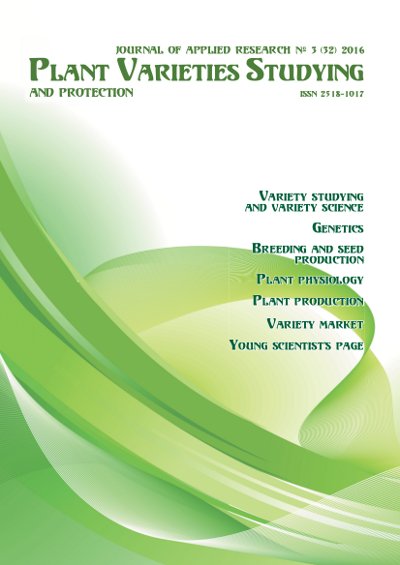Comparative analysis of starch grain size distribution in winter triticale samples
DOI:
https://doi.org/10.21498/2518-1017.3(32).2016.75981Keywords:
triticale, starch, grain size distributionAbstract
Purpose. Determination of the possibility to differentiate triticale samples by starch grain size and identify samples with a minimum size of granules that have a significant positive correlation with the efficiency of the starch transformation into ethanol.
Methods. Light microscopy of grinded triticale grains.
Results. Analysis of the starch granule size in triticale samples was performed. The minimum average granule size was observed in line Kc-270/14 (23.78 µm), maximum one – in line KR-110/14 (28.06 µm). The size of starch granules in a soft winter wheat variety ‘Tsvit Kalyny’ was 24.2 µm that was within the values typical for winter triticale varieties and lines. The size of the majority of granules ranged from 15 to 35 µm, but their distribution was uneven in the studied lines.
Conclusions. Considerable polymorphism of winter triticale for the starch granule size was established. It was found that the minimum average size of starch granules was observed in the samples characterized by minimum maximum size of granules, low frequency of granules of more than 35 µm, and therefore, minimum dispersion. Based on this, assumption can be made about the possibility to evaluate a sample for the presence of granules larger than 35 µm that can significantly reduce the number of measurements and speed up analysis.
Downloads
References
Rybalka, O. І. (2011). Yakist pshenytsi ta yii polipshennia [Wheat quality and its improvement]. Kyiv: Lohos. [in Ukrainian]
Chervonіs, M. V., & Surzhenko, І. O. (2009). Breeding criteria of grain crop varieties and hybrids for bioethanol production. Zbirnyk naukovykh prats SHI–NTsNS [Collected scientific articles of PBGI–NCSCI], 14, 27–36. [in Ukrainian]
Rybalka, O. І., Chervonіs, M. V., Morgun, B. V., Pochinok, V. M., & Polischuk, S. S. (2013). Genetic and breeding criteria of grain crop cultivars creation for ethanol distilling end-use. Fiziologiya i biokhimiya kul’turnykh rasteniy [Physiology and biochemistry of cultivated plants], 45(1), 3–19. [in Ukrainian]
Syrokhman, I. V., & Lozova, T. M. (2008). Tovaroznavstvo tsukru, medu, kondyterskykh vyrobiv [Merchandising of sugar, honey, confectionery]. (2nd ed. rev.). Kyiv: Tsentr uchbovoi literatury. [in Ukrainian]
Takhtadzhyan, A. L. (Ed). (1982). Zhizn rasteniy. T. 6: Tsvetkovye rasteniya [Life of Plants. Vol. 6: Flowering plants]. Moscow: Prosveshchenie. [in Russian]
Tymchuk, S. M., Martyniuk, M. M., Pozdnyakov, V. V., Tymchuk, V. M., Antsiferova, O. V., Kharchenko, Yu. V., & Kharchenko, L. Ya. (2012). Genetic analysis of the main features of granular starch in dent and waxy corn. Selektsia I Nasinnitstvo [Plant Breeding and Seed Production], 101, 198–206. [in Ukrainian]
Grabovets, A. I., Overchenko, M. B., Ignatova, N. I., & Hrichikova, G. N. (2015). Triticale breeding for fermentation production: results and problems. Zernobobovye i krupânye kul’tury [Leguminous and groat crops], 2(14), 63–68. [in Russian]
Grabovets, A. I., Andreev, N. R., Krokhmal, A. V., & Shevchenko, N. A. (2013). Problems of breeding triticale with a high grain starch content and its use. Doklady Rossiiskoi akademii sel’skokhozyaistvennykh nauk [Reports of the Russian Academy of agricultural sciences], 5, 14–16. [in Russian]
Downloads
Published
How to Cite
Issue
Section
License
Copyright (c) 2016 Ukrainian Institute for Plant Variety Examination

This work is licensed under a Creative Commons Attribution-ShareAlike 4.0 International License.
Starting in 2022, the copyright to the publication remains with the authors
Our journal abides by the CREATIVE COMMONS copyright rights and permissions for open access journals.
Authors, who are published in this journal, agree to the following conditions:
- The authors reserve the right to authorship of the work and pass the first publication right of this work to the journal under the terms of a Creative Commons Attribution License, which allows others to freely distribute the published research with the obligatory reference to the authors of the original work and the first publication of the work in this journal.
- The authors have the right to conclude separate supplement agreements that relate to non-exclusive work distribution in the form in which it has been published by the journal (for example, to upload the work to the online storage of the journal or publish it as part of a monograph), provided that the reference to the first publication of the work in this journal is included.

























 Ukrainian Institute for Plant Varieties Examination
Ukrainian Institute for Plant Varieties Examination  Селекційно-генетичний інститут
Селекційно-генетичний інститут Institute of Plant Physiology and Genetics of the National Academy of Sciences of Ukraine
Institute of Plant Physiology and Genetics of the National Academy of Sciences of Ukraine
 The National Academy of Agrarian Sciences of Ukraine
The National Academy of Agrarian Sciences of Ukraine